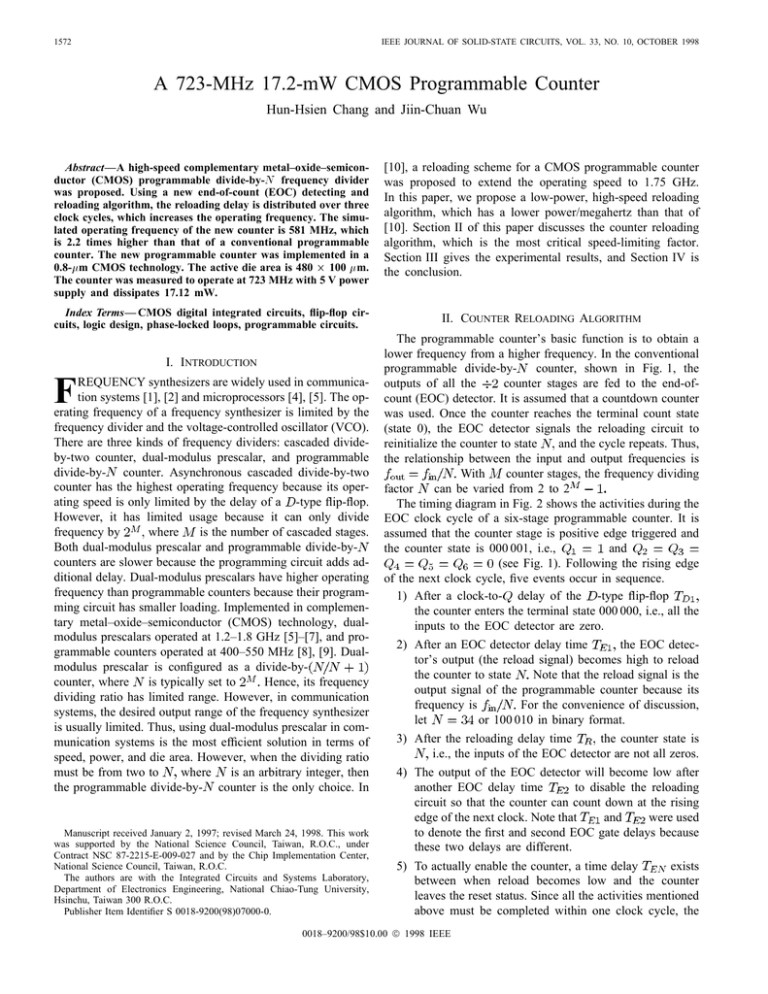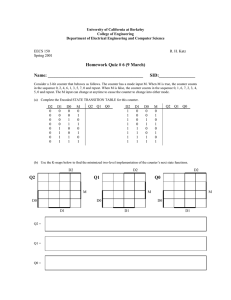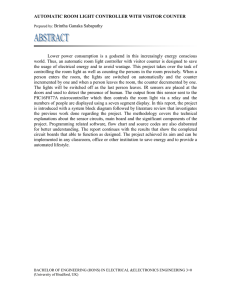frequency
advertisement

1572 IEEE JOURNAL OF SOLID-STATE CIRCUITS, VOL. 33, NO. 10, OCTOBER 1998 A 723-MHz 17.2-mW CMOS Programmable Counter Hun-Hsien Chang and Jiin-Chuan Wu Abstract—A high-speed complementary metal–oxide–semiconductor (CMOS) programmable divide-by-N frequency divider was proposed. Using a new end-of-count (EOC) detecting and reloading algorithm, the reloading delay is distributed over three clock cycles, which increases the operating frequency. The simulated operating frequency of the new counter is 581 MHz, which is 2.2 times higher than that of a conventional programmable counter. The new programmable counter was implemented in a 0.8-m CMOS technology. The active die area is 480 2 100 m. The counter was measured to operate at 723 MHz with 5 V power supply and dissipates 17.12 mW. [10], a reloading scheme for a CMOS programmable counter was proposed to extend the operating speed to 1.75 GHz. In this paper, we propose a low-power, high-speed reloading algorithm, which has a lower power/megahertz than that of [10]. Section II of this paper discusses the counter reloading algorithm, which is the most critical speed-limiting factor. Section III gives the experimental results, and Section IV is the conclusion. Index Terms— CMOS digital integrated circuits, flip-flop circuits, logic design, phase-locked loops, programmable circuits. II. COUNTER RELOADING ALGORITHM I. INTRODUCTION F REQUENCY synthesizers are widely used in communication systems [1], [2] and microprocessors [4], [5]. The operating frequency of a frequency synthesizer is limited by the frequency divider and the voltage-controlled oscillator (VCO). There are three kinds of frequency dividers: cascaded divideby-two counter, dual-modulus prescalar, and programmable divide-by- counter. Asynchronous cascaded divide-by-two counter has the highest operating frequency because its operating speed is only limited by the delay of a -type flip-flop. However, it has limited usage because it can only divide where is the number of cascaded stages. frequency by Both dual-modulus prescalar and programmable divide-bycounters are slower because the programming circuit adds additional delay. Dual-modulus prescalars have higher operating frequency than programmable counters because their programming circuit has smaller loading. Implemented in complementary metal–oxide–semiconductor (CMOS) technology, dualmodulus prescalars operated at 1.2–1.8 GHz [5]–[7], and programmable counters operated at 400–550 MHz [8], [9]. Dualmodulus prescalar is configured as a divide-bycounter, where is typically set to Hence, its frequency dividing ratio has limited range. However, in communication systems, the desired output range of the frequency synthesizer is usually limited. Thus, using dual-modulus prescalar in communication systems is the most efficient solution in terms of speed, power, and die area. However, when the dividing ratio where is an arbitrary integer, then must be from two to the programmable divide-by- counter is the only choice. In Manuscript received January 2, 1997; revised March 24, 1998. This work was supported by the National Science Council, Taiwan, R.O.C., under Contract NSC 87-2215-E-009-027 and by the Chip Implementation Center, National Science Council, Taiwan, R.O.C. The authors are with the Integrated Circuits and Systems Laboratory, Department of Electronics Engineering, National Chiao-Tung University, Hsinchu, Taiwan 300 R.O.C. Publisher Item Identifier S 0018-9200(98)07000-0. The programmable counter’s basic function is to obtain a lower frequency from a higher frequency. In the conventional counter, shown in Fig. 1, the programmable divide-bycounter stages are fed to the end-ofoutputs of all the count (EOC) detector. It is assumed that a countdown counter was used. Once the counter reaches the terminal count state (state 0), the EOC detector signals the reloading circuit to and the cycle repeats. Thus, reinitialize the counter to state the relationship between the input and output frequencies is With counter stages, the frequency dividing can be varied from 2 to 2 factor The timing diagram in Fig. 2 shows the activities during the EOC clock cycle of a six-stage programmable counter. It is assumed that the counter stage is positive edge triggered and the counter state is 000 001, i.e., and (see Fig. 1). Following the rising edge of the next clock cycle, five events occur in sequence. 1) After a clock-to- delay of the -type flip-flop the counter enters the terminal state 000 000, i.e., all the inputs to the EOC detector are zero. the EOC detec2) After an EOC detector delay time tor’s output (the reload signal) becomes high to reload Note that the reload signal is the the counter to state output signal of the programmable counter because its For the convenience of discussion, frequency is or 100 010 in binary format. let the counter state is 3) After the reloading delay time i.e., the inputs of the EOC detector are not all zeros. 4) The output of the EOC detector will become low after to disable the reloading another EOC delay time circuit so that the counter can count down at the rising and were used edge of the next clock. Note that to denote the first and second EOC gate delays because these two delays are different. exists 5) To actually enable the counter, a time delay between when reload becomes low and the counter leaves the reset status. Since all the activities mentioned above must be completed within one clock cycle, the 0018–9200/98$10.00 1998 IEEE IEEE JOURNAL OF SOLID-STATE CIRCUITS, VOL. 33, NO. 10, OCTOBER 1998 1573 Fig. 1. Block diagram of a programmable counter. N counter. Fig. 2. The timing of a conventional divide-by- Fig. 4. The simulation result of the traditional programmable counter operated at 263 MHz. Fig. 3. The traditional end-of-count detecting circuit. clock period must be greater than From the above analysis, it is clear that decreasing counter alone is not enough to increase the programmable delay counter’s speed greatly. The EOC detector delay and reloading delay also need to be minimized. Fig. 4 shows the simulation results of a conventional six-stage programmable counter, with the EOC detector shown in Fig. 3. The frequency dividing factor was set to 34. Comparing Figs. 2 and 4, one can find is 0.41 ns, is 0.66 ns, is 0.99 ns, is 1.12 that is 0.58 ns. The minimum clock cycle time is 3.8 ns, and ns, i.e., the maximum operating frequency is 263 MHz. Note that the first EOC delay TE1 is substantially smaller than the second EOC delay The new EOC circuit is shown in Fig. 5. This EOC detector is modified to detect the 000 010 state instead of the allzero condition. The output of the EOC detector (node is connected to a one-bit register that is clocked by the input The simulated timing diagram of the last three clock clock cycle is shown in cycles in a countdown-by- Fig. 5. The new end-of-count detector with Q0 feedback. 0 Fig. 6. Following the rising edge of the third to last clock cycle, the counter state changes from 000 011–000 010 after a Then, the EOC detector output clock-to- delay becomes high after an EOC delay time (delay from node to in Fig. 5), which is equal to one NAND gate delay plus one NOR gate delay. These two operations must be finished Following within one clock cycle, i.e., the rising edge of the second to last clock cycle, the output becomes low after the clock-toof the one-bit register delay of the one-bit register The node becomes which is node to low after another EOC delay delay. Node D0 must return to zero within this clock cycle, In the meantime, the reload signal i.e., becomes high after an inverter delay, which causes the counter 1574 IEEE JOURNAL OF SOLID-STATE CIRCUITS, VOL. 33, NO. 10, OCTOBER 1998 Fig. 7. The photograph of the proposed chip. Fig. 6. The simulation result of the new programmable counter operated at 581 MHz. to be reset to state The counter reloading time is the time from ’s becoming low to the counter state’s becoming Note that the resetting of the counter state to does not have to finish within this cycle; this will be explained below. Following the rising edge of the last clock cycle, the counter remains in state because the reload signal is high at the clock’s rising edge. Since must be low by the end of the previous clock cycle, the rising edge of this clock cycle sets to high after a - delay, which releases the counter stages from the reloading status so that the counter stages can count down again at the next rising edge of the input clock. This (set signal of counter stage being condition is seen as reset to zero. The counter enabling delay is the time from ’s becoming high to ’s becoming low. Thus, the timing constraint is However, there is another timing constraint. After becomes one, is no longer forced to zero by and the value of is now determined by the value i.e., before the end of this clock cycle, must be set to zero by the EOC detector. The timing constraint starts at the second last cycle. After a - delay, becomes low; delay, the counter value is set to after an EOC after a detector delay which is the delay from the higher four bits to node should be zero within two clock cycles. Thus, the timing constraint is In this way, the time to reinitialize the counter stages is extended to three clock cycles, i.e., the operating frequency will be increased. From the simulation results shown in Fig. 6, one can find that is 0.73 ns, - is 0.38 ns, - is 0.54 ns, is 0.46 ns, is 0.8 ns, is 1.37 ns, and is 1.35 ns. The minimum clock cycle time is 1.72 ns, i.e., the maximum operating frequency is 581 MHz, which is 2.2 times higher than the 263 MHz of a conventional programmable counter. Note that slower speed static -type flip-flops and logic gates, instead of the faster dynamic gates in [5]–[7] and [10], were used in this design because our emphasis is on Fig. 8. Block diagram of test chip. reducing the critical path delay by means of a better algorithm, not by using a faster gate. The power consumption of the counter is 13.8 mW. The power of the six counter stages is 5.625, 2.933, 1.314, 0.677, 0.350, and 0.330 mW, respectively. The power consumption of the end-of-count and reloading circuits is 0.831 and 1.715 mW, respectively. It can be seen that most of the power is consumed in the counter stages. Note that the power consumption of the end-of-count and reloading e.g., if then circuits is inversely proportional to its power consumption will be doubled. III. EXPERIMENTAL RESULTS The proposed six-stage programmable counter was implemented in a 0.8- m CMOS technology. The active die area 100 m A chip photograph is shown in Fig. 7. is 480 The block diagram of the test chip is shown in Fig. 8. To avoid high-frequency input, an internal three-stage VCO and clock buffer were used to generate the input clock signal of the counter. A divide-by-eight frequency divider was added to reduce the frequency at Fvco8 output pin. Since the reload signal is high only for one clock period, i.e., about 1.7 ns at maximum operating frequency, a divide-by-two divider was used to obtain a 50%-duty Fout2 signal. Thus, the is the input clock measured Fout2 frequency multiplied by is the counter dividing factor. The frequency, where output of the fourth counter stage (Fq4b) is also probed. Fig. 9 shows the measured results of the programmable and 5 V power counter operating at 723 MHz, with supply. The horizontal scale is 10 ns per division. The upper trace is Fvco8, the middle trace is Fout2, and the lower trace the frequency of Fout2 is 1/48 is Fq4b. With The frequency of Fvco8 is 1/8 Thus, the frequency IEEE JOURNAL OF SOLID-STATE CIRCUITS, VOL. 33, NO. 10, OCTOBER 1998 SUMMARY 1575 TABLE I MEASURED RESULTS OF from 2 to 2 According to simulation, the new algorithm improves the operating frequency by 2.2 times, from 263 to 581 MHz. The new six-stage programmable counter was implemented in a 0.8- m CMOS technology, and the active die area is 480 100 m The measured operating frequency is 723 MHz with 5 V power supply and dissipates 17.12 mW. REFERENCES Fig. 9. The measurement results of the new programmable counter operated at 5 V power supply and 723 MHz. of Fvco8 should be six times that of the Fout2, which is observed in Fig. 9. The waveform of Fq4b repeats with a period of 24 clock cycles. The performance of the counter is listed in Table I. The counter was measured to operate at 723 MHz with 5 V power supply and dissipates 17.12 mW. The measured power includes the power of the clock buffer but does not include the power of the on-chip VCO. The power dissipation per megahertz of this counter is 23.7 W/MHz. As a comparison, the performance of other CMOS divide-bycounters was 200 W/MHz [8], 16.9 W/MHz [9], and 28.6–34.3 W/MHz [10]. This counter had been integrated in a 1–600-MHz phase-locked loop that has a 80 ps measured jitter [11]. IV. CONCLUSIONS A new end-of-count detecting and reloading algorithm has been introduced for a low-power, high-speed programmable divide-by- frequency divider. The counter implemented was a six-bit programmable counter, but the design methodology can be extended to an -bit counter and can be programmed [1] J. Craninckx and M. Steyaert, “A 1.8-GHz CMOS low-phase-noise voltage controlled oscillator with pre-scalar,” IEEE J. Solid-State Circuits, vol. 30, pp. 1474–1482, Dec. 1995. [2] A. Rofougaran, J. Y. C. Chang, M. Rofougaran, and A. A. Abidi, “A 1 GHz CMOS RF front-end IC for a direct conversion wireless receiver,” IEEE J. Solid-State Circuits, vol. 31, pp. 880–889, July 1996. [3] I. A. Young, J. K. Greason, and K. L. Wong, “A Pll clock generator with 5–110 MHz of lock range for microprocessors,” IEEE J. Solid-State Circuits, vol. 27, pp. 1599–1607, Nov. 1992. [4] I. I. Novof, J. Austin, R. Kelkar, D. Strayer, and S. Wyatt, “Fullyintegrated CMOS phase-locked loop with 15–240 MHz locking range and 50 ps jitter,” IEEE J. Solid-State Circuits, vol. 30, pp. 1259–1266, Nov. 1995. [5] N. Foroudi and T. A. Kwasniewski, “CMOS high-speed dual-modulus frequency divider for RF frequency synthesis,” IEEE J. Solid-State Circuits, vol. 30, pp. 93–100, Feb. 1995. [6] B. Chang, J. Park, and W. Kim, “A 1.2 GHz CMOS dual-modulus prescalar using new dynamic D -type flip-flop,” IEEE J. Solid-State Circuits, vol. 31, pp. 749–752, May 1996. [7] J. Craninckx and M. Steyaert, “A 1.75-GHz/3-V dual-modulus divideby-128/129 pre-scalar in 0.7-m CMOS,” IEEE J. Solid-State Circuits, vol. 31, pp. 890–897, Feb. 1996. [8] P. Larsson, “A wide-range programmable high-speed CMOS frequency divider,” in Proc. IEEE Int. Symp. Circuits and Systems, 1995, pp. 195–198. [9] J. C. Wu and H. H. Chang, “A 550 MHz 9.3 mW CMOS frequency divider,” in Proc. IEEE Int. Symp. Circuits and Systems, 1995, pp. 199–202. [10] P. Larsson, “High-speed architecture for a programmable frequency divider and a dual-modulus prescaler,” IEEE J. Solid-State Circuits, vol. 31, pp. 744–748, Feb. 1996. [11] P. C. Yu and J. C. Wu, “A fully integrated 3.3 V 1-600 MHz CMOS frequency synthesizer,” in Proc. IEEE Int. Symp. Circuits and Systems, 1997, pp. 1828–1831. 6


